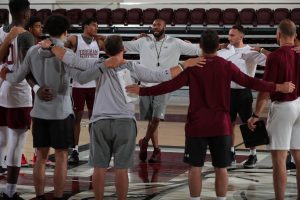Ambitious Marketing Maintains the Relevance of the Oldest Arena in the NCAA
The Rose Hill Gymnasium is a standout in the A10 for its long legacy, preserved since its opening in 1925
COURTESY OF FORDHAM UNIVERSITY ARCHIVES
The gymnasium was originally the largest structure on campus. Today it hosts the basketball and volleyball programs.
February 18, 2022
The Rose Hill Gymnasium has stood for nearly 100 years. While the rest of the NCAA features massive, high-tech arenas with jumbotrons and nosebleeds, Fordham’s humble but historic facility is arguably the most unique outlier.
Opened in 1925, the quaint, exposed-brick building seats 3,200 and sits between the McGinley Center and Jack Coffey Field. Gothic architecture disguises its industrial and utilitarian interior. A steel lattice supports the relatively low ceiling, sharing what little space there is with jerseys and banners. Blinding fluorescent lights hang high above the bleachers, while large windows allow a decent day’s sunlight to diffuse across the space.
The hardwood has hosted legendary games and players. Fordham hall-of-famers Johnny Bach, Fordham College (FC) ’47; Ed Conlin, Gabelli School of Business ’55; Kenneth Charles, FC ’73; and Anne Gregory-O’Connell, FC ’80, have all had their stints on the floor. In plain view hang championship banners, reminding any visitor of the historic caliber of Fordham basketball.
Since the very beginning, the gymnasium has had episodes of peculiar juxtaposition.
Since the very beginning, the gymnasium has had episodes of peculiar juxtaposition. The 1925 opening contest was refereed by baseball great and Fordham alumnus Frankie Frisch, FC ’20. During World War II, the U.S. Army borrowed the floor space for a barracks. New York native and NBA icon Kareem Abdul-Jabbar played his final high school game here. The Rose Hill Gymnasium continues to host annual high school championship games today.
The gymnasium’s history goes far beyond just basketball. Due to its space and utility, it earned the nickname “the Prairie.” For decades, it was the largest interior space on the Rose Hill campus, until the opening of the adjacent Lombardi Center in 1976. It has hosted concerts, keynote addresses and even commencements. The Prairie has remained a staple of Fordham culture, even as new structures continue to rise around it.
In the 1970s, the gym was nearly replaced with a more modern facility. Football legend and namesake of the Super Bowl trophy Vince Lombardi, FC ’37, hosted a fundraiser for a 10,000-seat facility that would have rivaled that of the University of St. Louis. He passed away before the fundraiser could be completed, and the hallowed arena has stood ever since.
In an effort to continue this mission for the gymnasium, in the fall of 2021, the university hosted rapper A$AP Ferg, who performed in front of thousands of Fordham students to inaugurate the basketball season.
Historical aura is not the only thing that keeps this building in operation. It is beloved by Fordham students for being an integral part of the Rose Hill experience. Director of Intercollegiate Athletics Ed Kull believes that part of the allure of the gym is its social potential.
“I want it to be a real centralized social gathering place,” he said of his vision of the facility. “I want it to be part of (the students’) whole experience here at Fordham University.”
For Kull, it’s about school pride, and all of Fordham is included in writing the history of the Prairie. In an effort to continue this mission for the gymnasium, in the fall of 2021, the university hosted rapper A$AP Ferg, who performed in front of thousands of Fordham students to inaugurate the basketball season.
With the issue of engaging students comes an obvious question: What about Lincoln Center? Kull is dedicated to bringing in more school spirit from the Manhattan campus. On Dec. 12, 2021, the Rams played in a showcase game at the 20,000-seat Barclays Center, home of the Brooklyn Nets.
“I think that’s the benefit of having that Madison Square Garden or Barclays (Center) game every year,” Kull said. Keeping the game in the city, according to him, allows more flexibility for those curious Lincoln Center sports fans. The director also mentioned other benefits of playing in notable New York City locations.
“When there is that demand for the larger audience … we always have the opportunity to (play in) a larger arena,” Kull said.
The original hardwood is now on sale as a collectible.
But among the most notable efforts to preserve the Prairie and engage more students is a recent revamp of the hardwood. Kull claimed that the court, which had been in continuous use since its 1925 opening, was in dire need of replacement. It was fully removed along with a sublevel and replaced with a modern, shock-absorbing, moisture-proof wood surface.
An industrious undertaking, the replacement was completed in 2019 and necessitated a rebuild of the foundation. This was a direct result of the building’s age and the methods used in its original construction.
The original hardwood is now on sale as a collectible. Fordham University partnered with CollectibleXchange.com to provide unique memorabilia to anyone who wants a part of the gym. Pieces of the court are on display in glass cases, with some featuring photos of the gymnasium from past years. There is even a special edition collectible with images of the Fordham women’s basketball team’s Atlantic 10 (A10) Championship victory in 2019.
Fordham has struggled to market its aging arena to prospective players.
For basketball fans, the Rose Hill Gymnasium is a historic icon, and according to coaches and the media, it is “one of the top 10 venues to watch a college basketball game.” But for recruits, the facility has proved unattractive.
Other schools in the A10, like the University of St. Louis, attract recruits with their massive arenas and expansive training facilities, but Fordham has struggled to market its aging arena to prospective players. Instead, as Kull insisted, Fordham Athletics uses the university’s “top tier” academics to bring in new players.
“A tremendous recruiting tool for Fordham Athletics is the strong education,” Kull said of the recruitment practices. “Fordham student-athletes actually have a higher graduation rate than the rest of the students at Fordham University.” In 2020, 11 Fordham Athletics programs recorded a 100% graduation rate. The overall graduation rate was 96%; the NCAA average is 85%.
Fordham Athletics has made efforts to better market the Prairie to students and to the community, and its long history is a huge part of those efforts. The memorabilia on sale at CollectibleXchange is just one of the ways that the Rose Hill Gym is continuing to build its brand and retain its legacy as an icon of New York basketball.















Ted • Apr 21, 2022 at 11:55 pm
Fordham could build a new place in the parking lot they have. If they want to stay in the Atlantic 10 they should other they should go back to the Patriot League.
Joseph J. Sullivan, Jr. • Feb 28, 2022 at 12:34 pm
I very much enjoyed your article re: the Rose Hill Gym. I graduated in 1958 and during my undergraduate years, in addition to hosting some terrific basketball games, the RHG was the venue for numerous dances organized by classes and student organizations, including the US Army and US Air Force ROTC programs. Even alumni were invited back to attend some of the great concerts. I specifically recall attending a Kingston Trio Concert with my bride of 58 years in late 1962 or early 1963 before we wed. I have nothing but fond memories of the Rose Hill Gym!